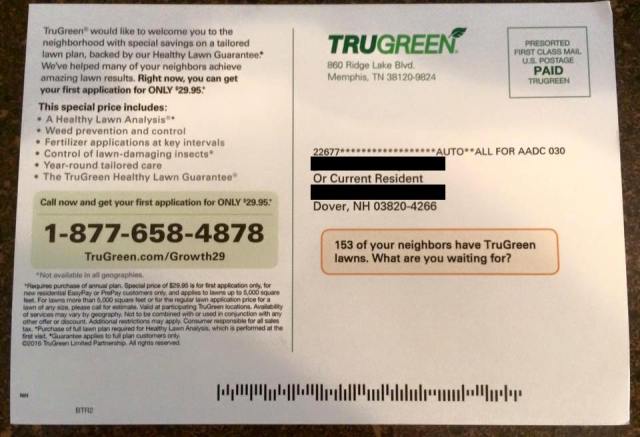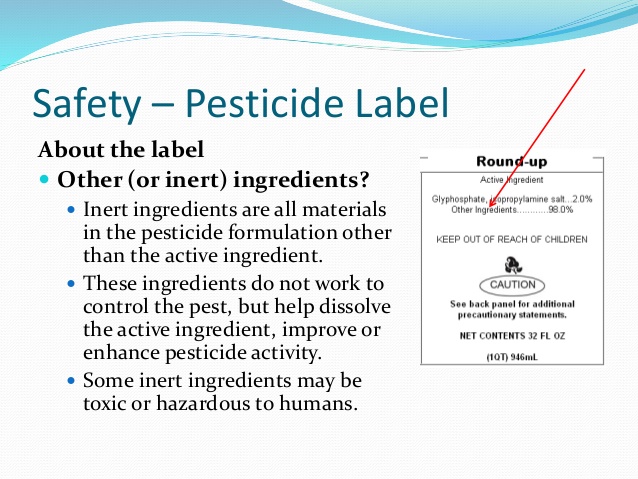To our neighbors:
We know it’s important to you to maintain your home. You’ve made an investment and you want to take care of it. Having a well kept lawn and yard is one of the ways you show that you are a good neighbor. You care about property values, not just your own, but those of the whole neighborhood.

You take pride in where you live, and for some of you, lawn care is considered part of your civic duty. You have put time and money into the appearance of your property because you care. We understand this and appreciate the gesture.
None of these things would we expect or even ask you to change, however, we’d like for you to take a moment to listen to the neighbors you care about, and consider a few things.
Approxiamtely 90 million pounds of pesticide active ingredients are used on U.S. lawns annually. Our culture has been sold on a $70 billion+ industry model for lawn care. Many of us have heard of a ‘4 step program’. Synthetic fertilizers, herbicides (both pre and post emergent), and insecticides are used, usually 4 or more times a season to get rid of ‘weeds‘ and grubs and green up the turf. Once you begin a program like this – whether you do it yourself by purchasing the ‘weed and feed’ formulas at the local hardware store, or hire a company to do it for you – you step onto what is known as the pesticide treadmill.

At every turn, promises of the ‘perfect’ lawn, but at what cost?
None of these products will actually eradicate the weeds or the insects – they aren’t meant to solve problems – you must keep using the product indefinitely. Year after year, you pay, they spray. This certainly benefits industry profits, but what about the rest of us?
The products that you are being told are essential to a nice lawn are legal, and they are regulated, and they are sold in stores. Many of you make the assumption that because of this, these products must also be safe. Unfortunately, this is not the case. There are many myths about pesticides. For example; the products being purchased and used by homeowners and lawn companies have not been appropriately tested or evaluated for many health effects.
Did you know, only active ingredients are required to be tested? That testing is done by the manufacturer and submitted to the regulatory agency. The EPA reviews the industry studies which are rarely, if at all, available to the public or published in any peer reviewed journals. The whole formulated product that ends up on your lawn is comprised of a percentage of active ingredient(s) and other or ‘inert’ ingredients.

Source: UC Davis
The whole product is not being tested. The chemicals it breaks down into are not tested. Combinations of active ingredients are not tested (like those in a 3-way herbicide product). They are not routinely evaluated for hormone mimicking effects known as endocrine disruption or for metabolic disruption or intergenerational effects (how will your children and grandchildren be effected by your exposure?) and neither are they tested for developmental toxicity.
Dozens of leading scientific and medical experts recently released a consensus statement on toxic chemicals and our children’s health. Their conclusion?
Based on these findings, we assert that the current system in the United States for evaluating scientific evidence and making health-based decisions about environmental chemicals is fundamentally broken. To help reduce the unacceptably high prevalence of neurodevelopmental disorders in our children, we must eliminate or significantly reduce exposures to chemicals that contribute to these conditions. We must adopt a new framework for assessing chemicals that have the potential to disrupt brain development and prevent the use of those that may pose a risk. This consensus statement lays the foundation for developing recommendations to monitor, assess, and reduce exposures to neurotoxic chemicals. These measures are urgently needed if we are to protect healthy brain development so that current and future generations can reach their fullest potential.
These products are linked by scientific evidence to a host of health problems for people and pets, and cause harm to the environment. Here are a few facts:
- In 2011, approximately 26.7 million tons of pollutants were emitted by gasoline powered lawn and garden equipment.
- Grass, per the EPA’s nationwide estimate, requires 9 billion gallons of water a day to keep green.
- Roundup, the world’s most popular herbicide is listed by the WHO as a probable carcinogen, shows evidence of endocrine disruption and is genotoxic – which means it damages DNA in a way that can lead to cancer.
- A 2015 meta analysis from Harvard University found a significant increase in the risk of childhood leukemia associated with herbicide exposure and also found that childhood exposure to residential insecticides was associated with a significant increase in risk of childhood leukemia and childhood lymphomas
- Neonicotinoids, are the most commonly used insecticide in the world. Both commercial and consumer grub control products are typically neonics like imidacloprid. In addition to being highly toxic to bees and songbirds, evidence is emerging that this class of pesticides pose a threat to the developing brain (Kara et al. 2015)
- Studies have linked lawn pesticides with canine malignant lymphoma and higher bladder cancer risk. Dogs also can expose their owners, children and other pets in the house to these chemicals. Researchers also found the widespread evidence of lawn chemicals in the urine of pet dogs. Even among dogs in households where chemicals were not applied.
- According to the Audubon Society of Connecticut, 76 million birds are killed annually by pesticides.
- 2,4-D, most famously known as a main component of Agent Orange, and the active ingredient in most ‘weed and feed’ products, is linked to numerous health effects like cancer and endocrine disruption. And the evidence continues to mount.
- Lawn pesticides end up in our drinking water. Out of the 30 most commonly used, 17 are detected in groundwater and 23 have the potential to leach.
- The chemicals we are exposed to in the environment are not tested for their combined effects, but scientists have found that many of these chemicals can increase cancer risks at the tiny levels we are being frequently exposed to.
This is very important information to think about. Please realize though, it is equally important for you to understand not just the health and environmental impacts of conventional lawn care, but how we are all personally effected by the lawn chemicals and the landscaping machines being used in our neighborhood.
We are prevented from growing vegetables gardens because of the drift coming from treated yards. We worry about the health of our children who play outside and are being exposed to the chemicals that have drifted over. When the truck came to spray your yard for mosquitoes, many of our honeybees died. Our chickens stopped laying eggs for several days after being exposed to chemical drift. We have seen the neighbors barefoot child run to catch their ball that rolled over into your grass just hours after it had herbicides and insecticides applied to it. We worry about our pets who, just like children, are highly vulnerable to exposure. We worry about our family member being treated for cancer and our loved one with a chronic illness. We worry about our unborn babies, whose development in the womb can be adversely effected by chemical exposures.
We have suffered severe asthma attacks requiring emergency room visits from the highly polluting gas leafblowers that the landscaping companies use. You can hear them on almost a daily basis here. The particulate matter like dust, pollen, animal feces and pesticide residue they launch into the air lingers for hours after they’ve packed up and left. We have watched your lawn care company blow the granules of insecticide back onto the grass after spreading it, and seen the visible clouds of poison dust they blow into the air. The landscapers leafblowers are spreading lead contaminated dust and dirt from yards where there are older homes that have been painted with lead based paint. Some of our children have lead poisoning.
We will likely never know the full impact of these lawn care practices on our health, or on the environment, however there exists more than enough information at this point to take a precautionary approach.
“When an activity raises threats of harm to human health or the environment, precautionary measures should be taken even if some cause and effect relationships are not fully established scientifically. In this context the proponent of an activity, rather than the public, should bear the burden of proof. The process of applying the precautionary principle must be open, informed and democratic and must include potentially affected parties. It must also involve an examination of the full range of alternatives, including no action.” – Wingspread Statement on the Precautionary Principle, Jan. 1998
Does this mean forgoing lawn care and having unkempt yards overgrown with crabgrass? Absolutely not! Maintaining your lawn can be done with natural methods. Using a systems based approach to lawn care is not only better for people, pets and the environment, but because you get off the pesticide treadmill, it saves you money in the long term due to decreased inputs. And if you are a DIY kind of person, it will save on labor as well.
Let us help you in making this change.
We can help you to find a good local company if you hire someone, and we can help you learn how to use a natural approach to lawn care if you do your own.
Join the Non Toxic Dover NH group, or How To Create a Non Toxic Community group on Facebook for assistance in making the switch to lawn care that meets everyone’s expectations and doesn’t take any risks with our health or our environment.
As a community we can put the focus on health, not just of our lawns but on residents of all species, and our natural resources – while at the same time cultivating healthy relationships with our neighbors. This is the new civic duty. Please join us.